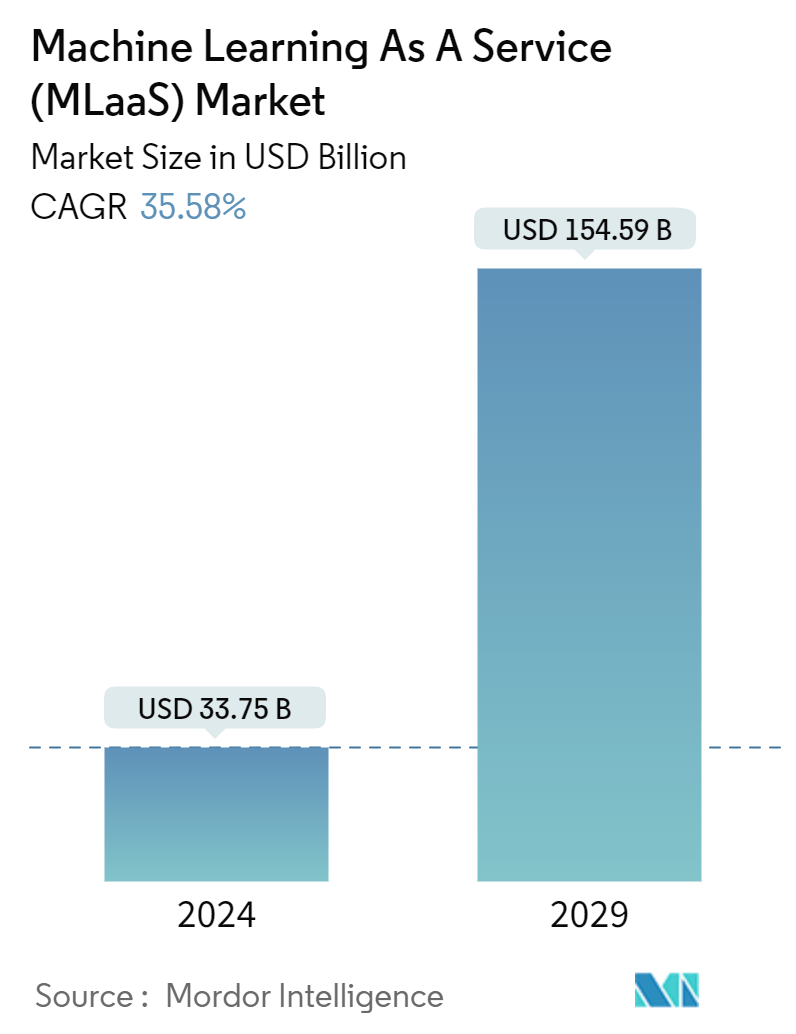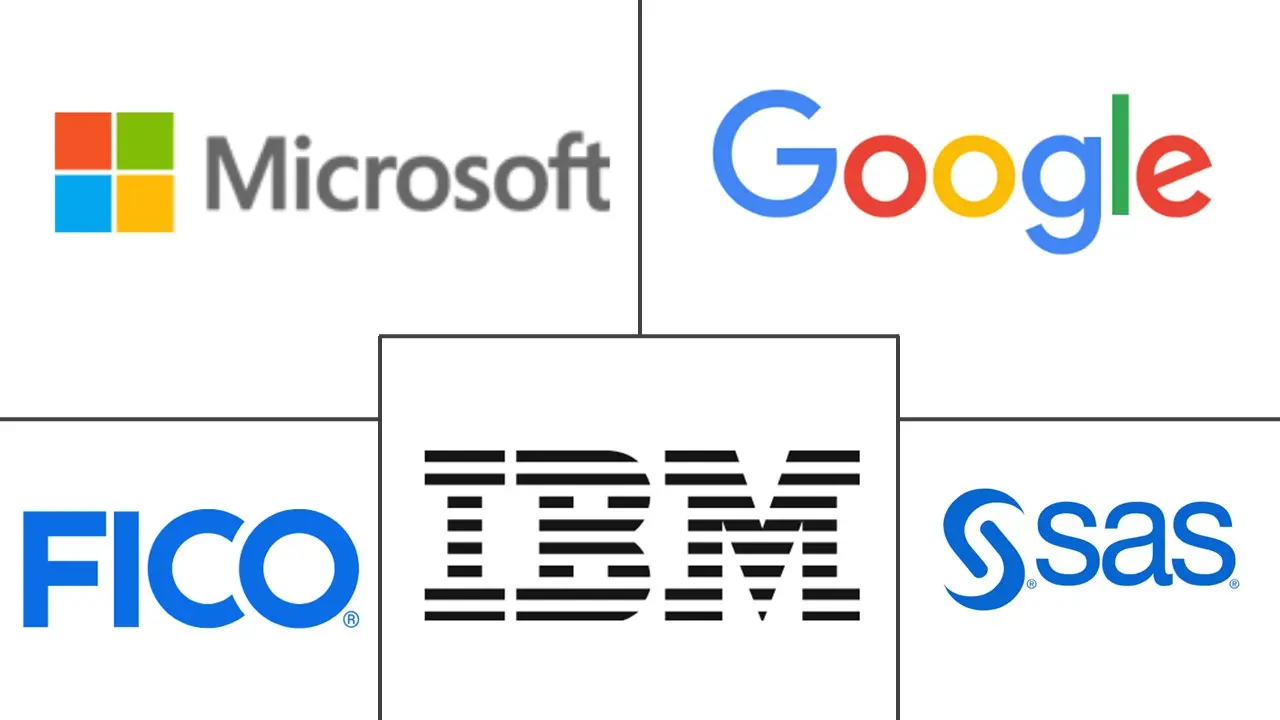Market Size of Machine Learning As A Service (MLaaS) Industry

| Study Period | 2019 - 2029 |
| Market Size (2024) | USD 33.75 Billion |
| Market Size (2029) | USD 154.59 Billion |
| CAGR (2024 - 2029) | 35.58 % |
| Fastest Growing Market | North America |
| Largest Market | North America |
| Market Concentration | Low |
Major Players
*Disclaimer: Major Players sorted in no particular order |
Machine Learning As A Service (MLaaS) Market Analysis
The Machine Learning As A Service Market size is estimated at USD 33.75 billion in 2024, and is expected to reach USD 154.59 billion by 2029, growing at a CAGR of 35.58% during the forecast period (2024-2029).
The Machine Learning as a Service market is evolving rapidly owing to the growing adoption of cloud-based services, IoT, and automation in businesses, the growing need among businesses for accelerated time to market for intelligent applications, the rising need to understand consumer behavior coupled with the growing need to enhance decision-making, automate processes, and drive innovation.
- MLaaS model is poised to dominate the market, with users having the option to choose from a wide variety of tools such as data visualization, APIs, face recognition, natural language processing, predictive analytics, and deep learning focused on different business needs. Advancements in data science and artificial intelligence have propelled the pace of machine learning's performance. Companies are increasingly recognizing the technology's potential, indicating a projected uptick in adoption rates of MLaaS over the forecast period.
- Moreover, MLaaS empowers businesses to leverage the potential of machine learning without the need for extensive in-house expertise, thus making it a valuable tool in fostering innovation and competitive advantage. Further, as businesses worldwide seek to leverage the predictive capabilities of machine learning in real-time scenarios, the demand for MLaaS platforms is analyzed to grow at a rapid pace among businesses to improve decision-making, automate processes, and enhance user experiences.
- Machine learning-as-a-service (MLaaS) is a pivotal feature within cloud computing offerings. With its array of tools, from data visualization and APIs to facial recognition, NLP, predictive analysis, and deep learning, MLaaS stands out as a comprehensive solution for businesses seeking to enhance their operations. The rapid expansion of cloud services and businesses increasingly transitioning to cloud platforms underscores a promising trajectory for MLaaS.
- Machine learning (ML) technology introduces a novel attack surface, garnering significant research attention. As ML integrates further into daily operations, spanning healthcare, finance, mobile devices, automotive systems, and home security, it inevitably becomes a prime target for cyber attackers.
- Post-pandemic, the spending on cloud services across enterprises is witnessing significant growth, which is analyzed to bolster the adoption of MLaaS platforms in the end-user sectors. For instance, according to Flexera Software's State of the Cloud Report 2024, by late 2024, 17% of enterprise respondents reported annual public cloud expenditures ranging from over USD 6 million to USD 12 million. Furthermore, by late 2024, 10% of enterprise respondents reported annual public cloud expenditures of more than USD 60 million. Moreover, 14% of enterprise respondents reported annual public cloud expenditures between USD 12 million and USD 24 million.
Machine Learning As A Service (MLaaS) Industry Segmentation
The Machine Learning as a Service (MLaaS) market is defined based on the revenues generated from the services used for a wide range of applications across various end users across the globe. The analysis is based on the market insights captured through secondary research and the primaries. The market also covers the major factors impacting the growth of the market in terms of drivers and restraints.
Machine learning as a service (MLaaS) market is segmented by application (marketing and advertisement, predictive maintenance, automated network management, fraud detection and risk analytics, and other applications), organization size (small and medium enterprises, large enterprises), end user (IT and telecom, automotive, healthcare, aerospace and defense, retail, government, BFSI, and other end users), and geography (North America, Europe, Asia-pacific, and Rest of the World). The market sizes and forecasts are provided in terms of value (USD) for all the above segments.
| By Application | |
| Marketing and Advertisement | |
| Predictive Maintenance | |
| Automated Network Management | |
| Fraud Detection and Risk Analytics | |
| Other Applications |
| By Organization Size | |
| Small and Medium Enterprises | |
| Large Enterprises |
| By End User | |
| IT and Telecom | |
| Automotive | |
| Healthcare | |
| Aerospace and Defense | |
| Retail | |
| Government | |
| BFSI | |
| Other End Users |
| By Geography*** | |
| North America | |
| Europe | |
| Asia | |
| Australia and New Zealand | |
| Latin America | |
| Middle East and Africa |
Machine Learning As A Service (MLaaS) Market Size Summary
The Machine Learning as a Service (MLaaS) market is experiencing rapid growth, driven by the increasing adoption of cloud-based services, IoT, and automation across various industries. This growth is fueled by the need for businesses to accelerate the time to market for intelligent applications, enhance decision-making, and drive innovation. The MLaaS model offers a comprehensive suite of tools, including data visualization, APIs, natural language processing, and predictive analytics, catering to diverse business needs. As advancements in data science and artificial intelligence continue to propel machine learning performance, companies are increasingly recognizing the technology's potential, leading to a projected increase in adoption rates over the forecast period. The ability of MLaaS to empower businesses without requiring extensive in-house expertise makes it a valuable asset for fostering innovation and gaining a competitive edge.
The healthcare sector, in particular, is witnessing significant traction in the adoption of MLaaS platforms, driven by the need to analyze vast amounts of patient data for improved disease diagnosis, drug discovery, and personalized treatment plans. The demand for MLaaS is further bolstered by its ability to manage staff schedules effectively and enhance patient care through advanced algorithms and predictive capabilities. Developments such as AWS HealthScribe, which leverages speech recognition and generative AI, exemplify the growing integration of MLaaS in healthcare. Additionally, the expanding use of IoT devices and cloud-based services in healthcare organizations is expected to further propel market growth. North America is anticipated to hold a significant market share due to its robust innovation ecosystem, strategic federal investments, and the presence of major players like Microsoft, IBM, and Google, who are actively enhancing their product offerings through partnerships and acquisitions.
Machine Learning As A Service (MLaaS) Market Size - Table of Contents
-
1. MARKET INSIGHTS
-
1.1 Market Overview
-
1.2 Industry Attractiveness - Porter's Five Forces Analysis
-
1.2.1 Bargaining Power of Suppliers
-
1.2.2 Bargaining Power of Buyers
-
1.2.3 Threat of New Entrants
-
1.2.4 Threat of Substitute Products
-
1.2.5 Intensity of Competitive Rivalry
-
-
1.3 Industry Value Chain Analysis
-
1.4 Assessment of COVID-19 Impact on the Market
-
-
2. MARKET SEGMENTATION
-
2.1 By Application
-
2.1.1 Marketing and Advertisement
-
2.1.2 Predictive Maintenance
-
2.1.3 Automated Network Management
-
2.1.4 Fraud Detection and Risk Analytics
-
2.1.5 Other Applications
-
-
2.2 By Organization Size
-
2.2.1 Small and Medium Enterprises
-
2.2.2 Large Enterprises
-
-
2.3 By End User
-
2.3.1 IT and Telecom
-
2.3.2 Automotive
-
2.3.3 Healthcare
-
2.3.4 Aerospace and Defense
-
2.3.5 Retail
-
2.3.6 Government
-
2.3.7 BFSI
-
2.3.8 Other End Users
-
-
2.4 By Geography***
-
2.4.1 North America
-
2.4.2 Europe
-
2.4.3 Asia
-
2.4.4 Australia and New Zealand
-
2.4.5 Latin America
-
2.4.6 Middle East and Africa
-
-
Machine Learning As A Service (MLaaS) Market Size FAQs
How big is the Machine Learning As A Service Market?
The Machine Learning As A Service Market size is expected to reach USD 33.75 billion in 2024 and grow at a CAGR of 35.58% to reach USD 154.59 billion by 2029.
What is the current Machine Learning As A Service Market size?
In 2024, the Machine Learning As A Service Market size is expected to reach USD 33.75 billion.

